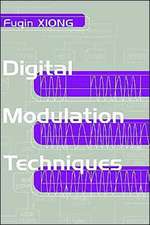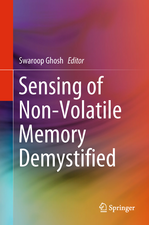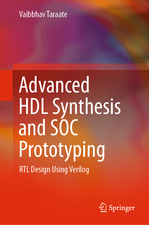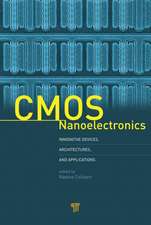Introduction to Logic Circuits & Logic Design with VHDL
Autor Brock J. LaMeresen Limba Engleză Hardback – 26 mar 2019
This textbook enables readers to design digital systems using the modern HDL approach while ensuring they have a solid foundation of knowledge of the underlying hardware and theory of their designs. This book is designed to match the way the material is actually taught in the classroom. Topics are presented in a manner which builds foundational knowledge before moving onto advanced topics. The author has designed the content with learning goals and assessment at its core. Each section addresses a specific learning outcome that the learner should be able to “do” after its completion. The concept checks and exercise problems provide a rich set of assessment tools to measure learner performance on each outcome.
This book can be used for either a sequence of two courses consisting of an introduction to logic circuits (Chapters 1-7) followed by logic design (Chapters 8-13) or a single, accelerated course that uses the early chapters as reference material.
Preț: 498.63 lei
Preț vechi: 600.77 lei
-17% Nou
Puncte Express: 748
Preț estimativ în valută:
95.44€ • 103.71$ • 80.22£
95.44€ • 103.71$ • 80.22£
Carte disponibilă
Livrare economică 31 martie-14 aprilie
Livrare express 14-20 martie pentru 57.35 lei
Preluare comenzi: 021 569.72.76
Specificații
ISBN-13: 9783030124885
ISBN-10: 3030124886
Pagini: 194
Ilustrații: XVI, 499 p. 505 illus., 454 illus. in color.
Dimensiuni: 178 x 254 x 31 mm
Greutate: 1.18 kg
Ediția:2nd ed. 2019
Editura: Springer International Publishing
Colecția Springer
Locul publicării:Cham, Switzerland
ISBN-10: 3030124886
Pagini: 194
Ilustrații: XVI, 499 p. 505 illus., 454 illus. in color.
Dimensiuni: 178 x 254 x 31 mm
Greutate: 1.18 kg
Ediția:2nd ed. 2019
Editura: Springer International Publishing
Colecția Springer
Locul publicării:Cham, Switzerland
Cuprins
Introduction.- Analog Vs. Digital.- Number Systems.- Digital Circuitry & Interfacing.- Combinational Logic Design.- VHDL (Part 1).- MSI Logic.- Sequential Logic Design.- VHDL (Part 2).- Behavioral Modeling Of Sequential Logic.- Memory.- Programmable Logic.- Arithmetic Circuits.- Computer System Design.
Notă biografică
Brock J. LaMeres is an Associate Professor in the Department of Electrical and Computer Engineering at Montana State University (MSU). His research interests are in the area of digital systems and engineering education. He has received numerous grants from the National Science Foundation and NASA to study how engineering students learn complex material and how to improve diversity within the field. His research has led to novel instructional methods that have been shown to improve student cognition while simultaneously promoting an inclusive learning environment. He has been honored with numerous teaching awards including the American Society of Engineering Education Section Outstanding Teaching Award, the MSU President’s Excellence in Teaching Award, the MSU Teaching Innovation Award, the MSU Excellence in Online Teaching Award, and the MSU Provost’s Award for Excellence in Teaching and Scholarship.
LaMeres received his Ph.D. in electrical engineering from the University of Colorado, Boulder in December of 2005, his MSEE from the University of Colorado, Colorado Springs in May of 2001, and his BSEE from Montana State University, Bozeman in December of 1998. Prior to joining the MSU faculty, he was an R&D engineer for Hewlett-Packard in Colorado Springs where he designed acquisition systems for electronic test equipment.
LaMeres has published over 80 manuscripts and 2 textbooks in the area of digital systems. LaMeres has also been granted 13 US patents in the area of digital signal propagation. LaMeres is a Senior Member of the Institute of Electrical and Electronic Engineers (IEEE) and a Registered Professional Engineer in the States of Montana and Colorado.
LaMeres received his Ph.D. in electrical engineering from the University of Colorado, Boulder in December of 2005, his MSEE from the University of Colorado, Colorado Springs in May of 2001, and his BSEE from Montana State University, Bozeman in December of 1998. Prior to joining the MSU faculty, he was an R&D engineer for Hewlett-Packard in Colorado Springs where he designed acquisition systems for electronic test equipment.
LaMeres has published over 80 manuscripts and 2 textbooks in the area of digital systems. LaMeres has also been granted 13 US patents in the area of digital signal propagation. LaMeres is a Senior Member of the Institute of Electrical and Electronic Engineers (IEEE) and a Registered Professional Engineer in the States of Montana and Colorado.
Textul de pe ultima copertă
This textbook introduces readers to the fundamental hardware used in modern computers. The only pre-requisite is algebra, so it can be taken by college freshman or sophomore students or even used in Advanced Placement courses in high school. This book presents both the classical approach to digital system design (i.e., pen and paper) in addition to the modern hardware description language (HDL) design approach (computer-based). This textbook enables readers to design digital systems using the modern HDL approach while ensuring they have a solid foundation of knowledge of the underlying hardware and theory of their designs. This book is designed to match the way the material is actually taught in the classroom. Topics are presented in a manner which builds foundational knowledge before moving onto advanced topics. The author has designed the content with learning goals and assessment at its core. Each section addresses a specific learning outcome that the learner should be able to “do” after its completion. The concept checks and exercise problems provide a rich set of assessment tools to measure learner performance on each outcome. This book can be used for either a sequence of two courses consisting of an introduction to logic circuits (Chapters 1-7) followed by logic design (Chapters 8-13) or a single, accelerated course that uses the early chapters as reference material.
- Written the way the material is taught, enabling a bottom-up approach to learning which culminates with a high-level of learning, with a solid foundation;
- Emphasizes examples from which students can learn: contains a solved example for nearly every section in the book;
- Includes more than 600 exercise problems, as well as concept check questions for each section, tied directly to specific learning outcomes.
Caracteristici
Written the way the material is taught, enabling a bottom-up approach to learning which culminates with a high-level of learning, with a solid foundation
Emphasizes examples from which students can learn: contains a solved example for nearly every section in the book
Includes more than 1000 exercise problems, as well as concept check questions for each section, tied directly to specific learning outcomes
Emphasizes examples from which students can learn: contains a solved example for nearly every section in the book
Includes more than 1000 exercise problems, as well as concept check questions for each section, tied directly to specific learning outcomes






















